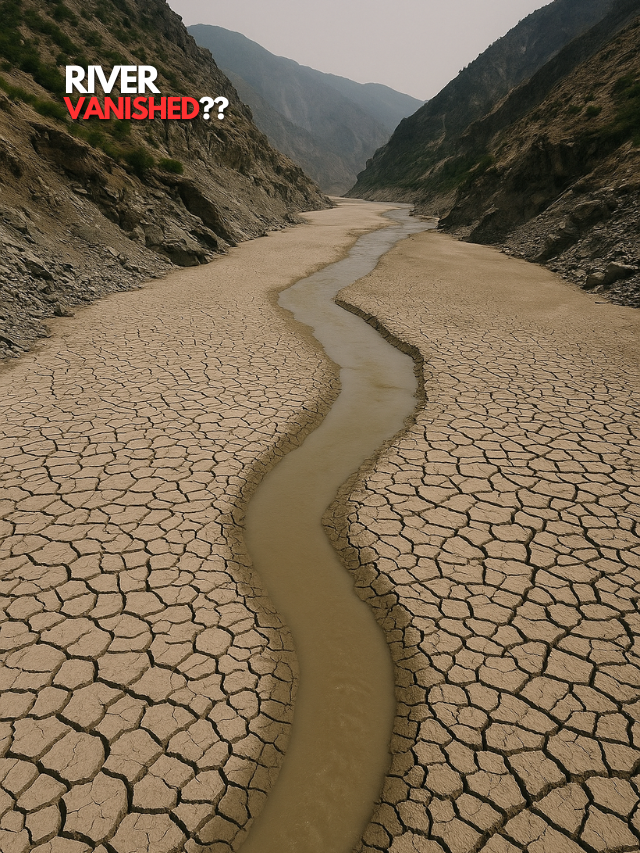Summary
- Satellite data reveals a 75% decline in Sutlej River flow into India over the past five years, from 8,000 to 2,000 gigaliters.
- China has the technical capability to control this flow via infrastructure at Zada Gorge in Tibet, but no formal treaty binds it to transparency.
- Climate change and glacial melt may be contributing, but the absence of bilateral oversight raises alarm over water security and strategic vulnerability.
A River Runs Dry—And So Does Trust
The waters of the Sutlej River—once a vital artery flowing from the Tibetan plateau into Himachal Pradesh and Punjab—are receding. But as river levels drop, questions surge. Is it nature’s hand, or geopolitical design?
This is the unsettling dilemma posed by Dr. Y Nithiyanandam, a geospatial researcher and former NASA station manager, who has released satellite data showing a staggering 75% reduction in the river’s flow into India over the last five years. From 8,000 gigaliters annually down to 2,000, the drop has set off alarm bells across India’s water security community.
The implications go beyond irrigation and ecology. The Sutlej feeds farmlands, supports hydroelectric infrastructure, and serves as a geopolitical fault line—because upstream, it is controlled by China.
Is China already controlling the water that flows into India?
— Dr Y Nithiyanandam (@prof_nithiya) May 23, 2025
Satellite data shows a sharp decline — water flow in the Sutlej basin before it enters India has dropped by >75% in 5 years, from ~8000 GL to ~2000 GL.
A glimpse from our #TakshashilaGeospatialBulletin 👉… pic.twitter.com/jL0M2TSGru
A Damning Decline: What the Data Shows
- Nithiyanandam’s post on X used satellite-based hydrological estimates to show a sharp reduction in inflow volume into Indian territory.
- The Zada Gorge in Tibet, where China has built hydroelectric infrastructure, allows Beijing to alter water discharge levels.
- India and China have no water-sharing treaty—only a data-sharing agreement that expired in 2023.
- China is under no legal obligation to disclose how much water it stores, diverts, or releases into transboundary rivers like the Sutlej.
- No formal complaint has been filed, but Indian researchers are urging the government to verify flow manipulation.
The visual data is stark—but it’s the context that’s more alarming. Beijing’s hydro infrastructure gives it the capacity to regulate the Sutlej, and without any enforceable transparency agreements, India has no way to verify what’s happening upstream.
India and China have faced friction before over water. In 2017, during the Doklam standoff, China temporarily stopped sharing Brahmaputra water data—crippling India’s flood forecasting systems. The current decline in Sutlej flow may be nature’s doing—but the strategic pattern is impossible to ignore.
Melting Glaciers, Drying Rivers: Climate Isn’t Off the Hook
- The Sutlej is primarily fed by snow and glacier melt—over 50% of its total volume.
- Himalayan glacier loss has already reached 21% since the 1980s; some estimates suggest 55% could vanish by 2050.
- In the short term, glacial melt increases runoff—but once critical mass is lost, flow collapses sharply.
- Some climate scientists argue that the observed drop may signal the beginning of irreversible hydro decline.
Climate change complicates the narrative. Rapid glacier loss in the Himalayas has entered a paradoxical phase: at first, meltwater volume surges—but once too much ice disappears, river volumes collapse.
The Sutlej may be hitting that tipping point. If true, the water crisis is only just beginning, and no dam diplomacy will solve it. But the absence of open scientific data between China and India makes it impossible to know whether climate is the dominant force—or a convenient mask.
When Water Becomes a Weapon
- With no treaty, India has no recourse if China manipulates river flow in peacetime—or wartime.
- Water coercion is an emerging threat in global diplomacy, especially in transboundary river zones like the Himalayas.
- Experts are calling for India to push for a new multilateral water framework, involving satellite verification and automated hydrological sensors.
- China’s opaque hydro strategy is seen by many as part of its larger “Salami Slicing” tactics—subtle, deniable actions with cumulative strategic gains.
If the flow drop is politically engineered, it may be part of a broader toolkit: economic coercion, cyber warfare, border salami-slicing—and now, hydro-hybrid pressure. Unlike troop movements or sanctions, water manipulation is quiet, hard to prove, and devastatingly effective.
Even without proof of intent, the capability gap is glaring. China can store, divert, or release water with precision. India, downstream and in the dark, remains vulnerable.
The lack of treaty doesn’t just mean no recourse—it means no early warning. No accountability. No certainty. In the world of strategic deterrence, that’s a recipe for disaster.
A River’s Silence, A Nation’s Wake-Up Call
The Sutlej River is more than a waterway. It’s a test of regional diplomacy, environmental foresight, and national preparedness. Whether the cause is glacial decay or quiet coercion, the result is the same: India’s northern basin is drying, and nobody’s talking.
India must now act on two fronts: deepen satellite-based hydrological surveillance, and push for regional water security frameworks. Whether through BIMSTEC, BRICS, or bilateral diplomacy, water must become a central pillar of strategic dialogue—not just a seasonal crisis.
In the geopolitics of the 21st century, wars may not be fought over rivers—but they will be shaped by them.



